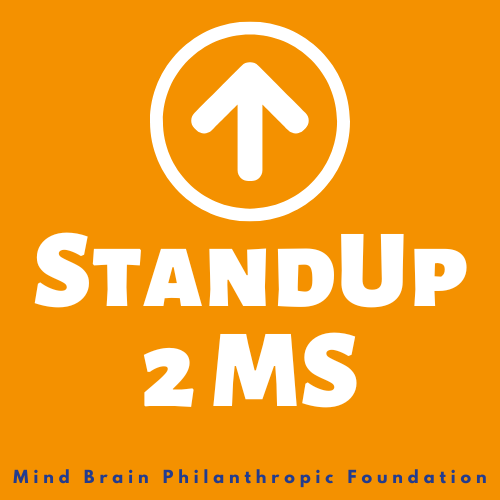New York, NY. - Mind Brain Philanthropic Foundation d/b/a MS Stand-Up, a non-profit foundation,...
What Does Standing Have To Do With the EDSS?
Standing, Multiple Sclerosis, and the EDSS - how do these relate?
Understanding Multiple Sclerosis in objective, ongoing, and measurable terms is important to the MS patient, the MS neurologist, and MS researchers.
Objective measurements can help track the patient’s condition. Upcoming posts on this Standup2MS blog will be about tools used to assess MS progression in patients.
The Kurtzke Expanded Disability Status Scale (EDSS)
In this post, I’ll discuss the EDSS - the Expanded Disability Status Scale - used in clinics and for research everywhere.
In the second, I will talk about what I’ve been doing to improve my own score and get out of this wheelchair.
In a subsequent post, I’ll discuss a test being developed by Dr. Victoria Leavitt to test the cognitive issues that are not addressed in the EDSS.
The last post in the series will explore the BeCare app, which offers cognitive and physical exercises that can be tracked.

What Is the Kurtzke Expanded Disability Status Scale?
According to the Multiple Sclerosis Centers of Excellence, Dr. John Kurtzke developed the first version of the EDSS in the 1950s. His goal was to consistently quantify the level of disability of people with Multiple Sclerosis to help healthcare providers.
"The purpose was to create an objective approach to quantify the level of functioning that could be widely used by health care providers diagnosing MS."
Over time, the scale evolved to better reflect clinical observations. It is currently known as the Kurtzke Expanded Disability Status Scale (EDSS).
How Does the EDSS Work?
Standing up and walking is how MS patients, their doctors, and doctors researching the condition tend to evaluate MS.
The EDSS is a standard assessment that every MS patient will likely encounter during their visits to a neurologist. The timed 25-foot walk, a core element of the EDSS, is a common metric for evaluating MS patients in both clinical settings and research studies.
When you look at the EDSS, you'll notice numbers ranging from 0 to 10, with 0 representing normal functioning and 10 being death.
The physician asks the MS patient to perform various functions like a timed walk, along with other questions about the ease or difficulty in performing the day-to-day tasks of life. The observations are then given a numerical “score”.
How Do the Scores Relate to the Level of Disability?
Levels 1.0 to 4.5 reflect a high degree of function as it relates to physical activity.
1.0: No disability.
1.5: Slightly more than zero disability.
2.0: Minimal disability.
2.5: Slightly more than minimal disability.
3.0: Moderate disability in one factor or mild disability in three or four factors though fully ambulatory.
3.5: Fully ambulatory but with moderate disability in one or two factors.
4.0: Fully ambulatory without aid, self-sufficient, up and about some 12 hours a day despite relatively severe disability, or combination of lesser grades but able to walk without aid or rest greater than 500 meters.
4.5: Fully ambulatory without aid, up and about much of the day, able to work a full day, may otherwise have some limitation of full activity or require minimal assistance; characterized by relatively severe disability or combinations of lesser grades exceeding limits of previous steps; able to walk without aid or rest greater than 300 meters.
The midpoint of the EDSS begins the tracking of physical disability, with movement becoming increasingly difficult. Subsequent levels 5.0 to 9.5 refer to the loss of ambulatory ability.
5.0: Ambulatory without aid or rest for about 200 meters; disability severe enough to impair full daily activities (e.g., to work a full day without special provisions) or combinations of lesser grades usually exceeding specifications for step 4.0
5.5: Ambulatory without aid for about 100 meters; disability severe enough to preclude full daily activities or a combination of lesser grades usually exceeding those for step 4.0).
6.0: Intermittent or unilateral constant assistance (cane, crutch, brace) is required to walk about 100 meters with or without resting.
6.5: Constant bilateral assistance (canes, crutches, braces) is required to walk about 20 meters without resting.
7.0: Unable to walk beyond approximately 5 meters even with aid, essentially restricted to wheelchair; wheels self in a standard wheelchair and transfers alone; up and about in wheelchair some 12 hours a day.
7.5: Unable to take more than a few steps; restricted to wheelchair; may need aid in transfer; wheels self but cannot carry on in standard wheelchair a full day. May require a motorized wheelchair.
8.0: Essentially restricted to bed or chair or perambulated in a wheelchair, but may be out of bed itself much of the day; retains many self-care functions; generally has effective use of arms.
8.5: Essentially restricted to bed much of day; has some effective use of arm(s); retains some self-care functions.
9.0: Bed patient; can communicate and eat.
9.5: Bed patient; unable to communicate effectively or eat/swallow.
10.0: Death due to MS
In the above scale descriptions, I have abbreviated some of the complexities and detailed measurements.
The EDSS measurement is widely used and is useful to track and monitor a patient’s condition. However, like all measurement systems, EDSS has limitations. More specifically, EDSS focuses on measuring physical activity and gives little weight to cognitive function.
As one Neurologist said at a conference in Salzburg, Vienna,
“You could be demented but get a fine score on the EDSS.”
Physicians and researchers have taken note and have looked to other forms of measurement to incorporate different aspects of human activity.
In the next blog article, I will go into how Im tailoring my workout schedule to result in a better EDSS score.

About StandUp2MS
StandUp2MS is a campaign of the Mind Brain Philanthropic Foundation.
The goal of StandUp2MS is to raise funds to move forward with ground-breaking medical research to understand MS better and to find better treatments and hopefully a cure.
As part of our fundraising efforts, we will feature articles like this one to help educate patients and the public about MS and to build a wide community to support those who suffer from this illness and those who care for those with MS.
Thanks for reading!
Image source for The Extended Disability Status Scale (EDSS) (Kurtzke, 1983): https://my-ms.org/ms_progression.htm


